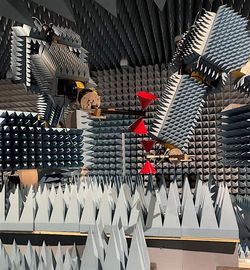Advancements in EMC Design and Test: Half-Day Workshop with LIVE Demo!
29 Aug 2025
The IEEE UK & Ireland EMC Chapter is delighted to invite you to a FREE to attend half-day IN PERSON workshop with international expert speakers and a demo in a semi-anechoic EMC test chamber.
Date and time
Wednesday, 10th September ·
1:00 - 5:00 pm (GMT+1)
Location
Element Surrey Hills
Unit 15B Henley Business Park Normandy GU3 2DX Get directions
AGENDA
1:00 pm - LUNCH and Welcome from Element
2:00 pm - Presentation by Min Zhang, Mach One Design, UK
2:45 pm - Presentation by Dennis Lewis, The Boeing Company, Seattle, WA, USA
3:15 pm - BREAK
3:30 pm - Presentation by Zhong Chen, ETS-Lindgren, Cedar Park, TX, USA
4:30 pm - Demonstration in Semi-Anechoic Chamber
5:00 pm - ADJOURN
Many thanks to our meeting sponsor ETS-Lindgren for providing the lunch and refreshments.
Registration
There is no-cost to attend this workshop, but you must register in advance as space is limited!
Presentation titles and abstracts, as well as speaker bios
Troubleshooting EMI in the Time Domain: Essential Skills for Test and Design Engineers By Min Zhang, Ph.D., Founder and Principal EMC Consultant, Mach One Design, UK
Abstract: Most EMC engineers and design engineers are accustomed to performing EMI troubleshooting in the frequency domain using near-field probes and RF current probes since the majority of EMC tests are conducted this way. Time-domain analysis, by contrast, is often associated only with transient testing, such as fast transients or ESD events. By connecting near-field and current probes to multiple channels of a time-domain instrument such as an oscilloscope, engineers can unlock powerful new insights for EMI troubleshooting. With simultaneous, multi-channel measurements, it becomes possible to trace RF currents, correlate signals, and uncover the core design issues driving EMC failures. This presentation will introduce the fundamentals of time-domain EMI troubleshooting and feature live demonstrations to illustrate how these techniques can be applied effectively in real-world design and testing scenarios.
Biography: Min Zhang received his Ph.D. in Electrical and Electronic Engineering from Newcastle University in 2013, where his research focused on novel power switching schemes for reducing EMI emissions. His published work in this area has been widely cited. With over a decade of experience as a design engineer, he is now the founder and principal EMC consultant at Mach One Design Ltd, a UK-based firm specializing in EMC consulting, troubleshooting, and training. Dr. Zhang’s expertise spans power electronics, digital electronics, electric machines, and product design, enabling him to deliver practical solutions to companies worldwide. He currently serves as Chair of the IEEE EMC Society UK & Ireland Chapter.
The Impact of Cables and Connectors on Radio Frequency and Microwave Measurement Uncertainties By Dennis Lewis, Technical Fellow, The Boeing Company, Seattle, Washington, USA
Abstract: Microwave test and measurement equipment is used for many applications, including component measurements, electromagnetic compatibility testing, metrology and wireless environment assessments. Much of this equipment requires special care and consideration in order to eliminate damage and maintain a high level of accuracy. When developing these high frequency measurement systems and evaluating system performance, it is common to consider the warranted equipment specifications. Very often, however, the error contribution of cables and connectors to the system uncertainty is overlooked. Impedance mismatch is typically the largest source of measurement error and is largely influenced by the cables and connectors used within the system. Something as insignificant as a $30 connector can adversely affect the performance of a system costing several hundred thousand dollars. This presentation provides an overview of commonly used cables and connectors and discusses some of the errors associated with them. The impact of these errors on overall measurement system uncertainties is discussed. The presentation finishes with some practical examples and real world applications to help guide participants in the selection and use of cables and connectors and more accurately assess system performance.
Biography: Dennis Lewis received his BS EE degree with honors from Henry Cogswell College and his MS degree in Physics from the University of Washington. He has worked at Boeing for 34 years, and is recognized as a Technical Fellow, leading the enterprise antenna measurement capability for Boeing Test and Evaluation. Dennis holds eleven patents, and is the recipient of the 2013 and 2015 Boeing Special Invention Award. He is a senior member of the IEEE and several of its technical societies, including the Microwave Theory and Technology Society (MTT-S), the Antennas and Propagation Society (AP-S), and the Electromagnetic Compatibility (EMC) Society. He actively contributes to these societies as a member of the IEEE MTT-S Subcommittee 3 on Microwave Measurements, and as a Board Member and past Distinguished Lecturer for the EMC Society. He is a Fellow of served as Vice President on the Board of Directors for the Antenna Measurements Techniques Association (AMTA) and chaired its annual symposium in 2012 and 2023. Dennis developed and taught a course on Measurement Science at North Seattle College, and is a past chairman of its Technical Advisory Committee. His current technical interests include aerospace applications of reverberation chamber test techniques as well as microwave and antenna measurement systems and uncertainties.
CISPR and ANSC C63® Overview on Site Validation Measurements from 18 GHz to 40 GHz - Latest Advances in EMC Test Site Evaluation Using Advanced Antenna Measurement Techniques By Zhong Chen, Chief Engineer, ETS-Lindgren, Cedar Park, Texas, USA
Abstract: This presentation introduces a novel approach for EMC chamber validation beyond 18 GHz, currently under consideration in ANSI C63 and CISPR standards. By integrating Cylindrical Mode Filtered Site Voltage Standing Wave Ratio (CMF SVSWR) with Compressed Sensing (CS), we address inherent challenges in traditional SVSWR methods, such as inconsistency and slow data acquisition. CMF SVSWR utilizes circular path measurements and mode domain post-processing to discern antenna and chamber reflections, crucial for comprehensive VSWR analysis. Compressed Sensing, a data-driven machine learning technique, exploits signal sparsity to reconstruct data from fewer randomly sampled measurement points, thereby reducing test times and eliminating the need for precise turntable positioning.
Cylindrical Mode Filtered SVSWR Demonstration
Following the workshop presentations, Mr. Chen will conduct a LIVE demonstration in the Element EMC semi-anechoic test chamber.
Demonstration Abstract: The Cylindrical Mode Filtered SVSWR (CMF SVSWR) is measured by placing the transmit antenna (typically a low gain omni-directional antenna) at the edge of the turntable and performing a single cut vector pattern measurement. The vector S21 as a function of turntable angle at each frequency is transformed to the spectrum domain, where a filter can be applied to mathematically remove the chamber effects. The SVSWR is derived by comparing the original pattern in the chamber to the “clean” filtered pattern. This CMF SVSWR provides a more comprehensive evaluation of the EMC chamber quiet zone and can be readily measured without any special positioning fixtures. The demonstration will show an entire measurement process including the post processing which can be performed in real time. This new measurement technique is under consideration for the new draft standard ANSI C63.25.3 under development by the ANSC C63® committee for EMC test sites from 18 GHz to 40 GHz.
Biography: Zhong Chen is Chief Engineer at ETS-Lindgren, located in Cedar Park, Texas. He has over 25 years of experience in RF testing, anechoic chamber design, as well as EMC antenna and field probe design and measurements. He is an active member of the ANSC C63® committee currently serving as Vice-Chair and is the immediate past Chair of Subcommittee 1 which is responsible for the antenna calibration (ANSI C63.5) and chamber/test site validation standards (ANSI C63.4 and the ANSI C63.25 series). Mr. Chen is chair of the IEEE Standard 1309 committee responsible for developing calibration standards for field probes, and IEEE Standard 1128 for absorber evaluation. Currently he is a member of the IEEE EMC Society Board of Directors. He is a past Distinguished Lecturer for the EMC Society and is recognized as an AMTA Fellow. His research interests include measurement uncertainty, time domain measurements for site validation and antenna calibration, and development of novel RF absorber materials. Several papers authored and co-authored by Mr. Chen have received best paper recognition at global conferences. Zhong Chen received his M.S.E.E. degree in Electromagnetics from The Ohio State University at Columbus. He may be reached at zhong.chen@ets-lindgren.com.
Be part of this unique technical event. Secure your free place now by clicking here to register!
Get more from EMC Standards
EMC Standards is a world-leading resource for all things EMC and EMI related. Our website is packed full of both free and paid-for content, including:
- Online quiz
- Webinars
- Training quiz
- And much more!

Electromagnetic Engineering (EMgineering) is the basis for proven good design practices for signal integrity (SI), power integrity (PI), and the control of EMI emissions and immunity (EMC).
Our aim is to help people learn how to more quickly and cost-effectively design and manufacture electronic equipment (products, systems, installations, etc.) to meet functional (i.e. SI/PI) specifications and conform to EMC standards, directives and other requirements.
Such equipment should benefit from reduced warranty costs and financial risks, whilst improving uptime, competitiveness and profitability.
We also cover basic good electrical safety engineering; and the Risk Management of Electromagnetic Disturbances / EMI, whether for Functional Safety or other types of risk.
Join EMC standards TODAY!
